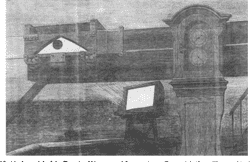Janssen revolver, Passage de Vénus 1874 - early film technology
The Janssen revolver was a revolutionary camera designed by French inventors Charles-Édouard Janssen and Louis Le Prince in 1874. This camera was designed to capture sequences of photographs on a single filmstrip, which was a major advancement in early film technology. This article will examine the significance of the Janssen revolver in the history of early film technology and its role in the Passage de Vénus project.
Before the Janssen revolver, the only way to capture moving images was through a series of individual still photographs taken in quick succession. These still photographs would then be viewed in rapid succession to create the illusion of motion. However, this method was not only time-consuming but also limited in terms of the number of images that could be captured. The Janssen revolver changed this by allowing photographers to capture multiple images on a single filmstrip.
The Janssen revolver was designed to take advantage of the new emulsion-coated glass plates that had recently been developed. These plates were covered in light-sensitive emulsion, which allowed them to capture images when exposed to light. The Janssen revolver was designed to hold a roll of these emulsion-coated glass plates and was equipped with a revolving drum that would move the glass plates into place one after the other. This allowed the camera to capture multiple images on a single filmstrip.
The Janssen revolver was first used in the Passage de Vénus project in 1874. This project was a collaboration between French astronomers and photographers to capture images of the Transit of Venus, a rare astronomical event in which the planet Venus passes between the Earth and the Sun. The Janssen revolver was used to capture multiple images of the Transit of Venus in rapid succession, which allowed astronomers to study the movement of the planet in great detail.
The Passage de Vénus project was a significant event in the history of astronomy and photography. It marked the first time that astronomers had used photography to study an astronomical event and demonstrated the potential of photography as a tool for scientific research. The images captured by the Janssen revolver were also the first moving images ever captured and represented a major step forward in the development of film technology.
In conclusion, the Janssen revolver was a revolutionary camera that represented a major advancement in early film technology. Its design allowed for the capture of multiple images on a single filmstrip, which paved the way for the creation of moving images and the film industry as we know it today.
The Passage de Vénus project demonstrated the potential of the Janssen revolver and showed that photography could be used for scientific research. The Janssen revolver was a significant piece of engineering that played a crucial role in the development of early film technology and remains an important part of the history of photography and the film industry.






Comments
Post a Comment